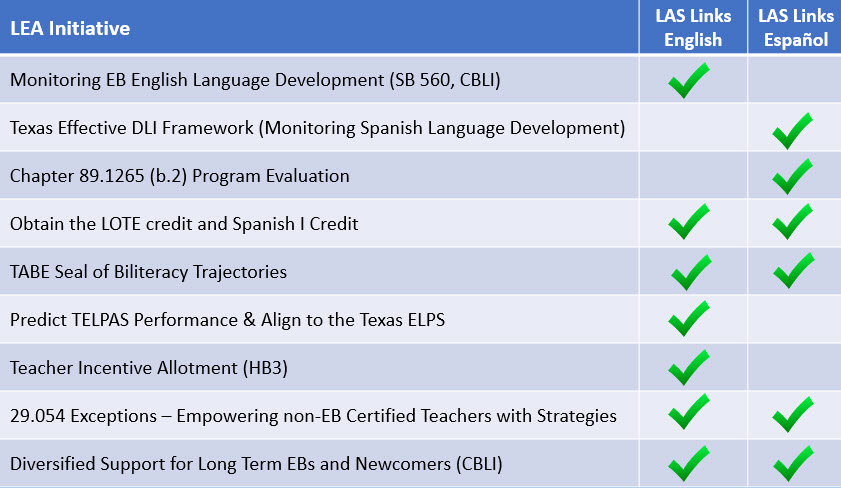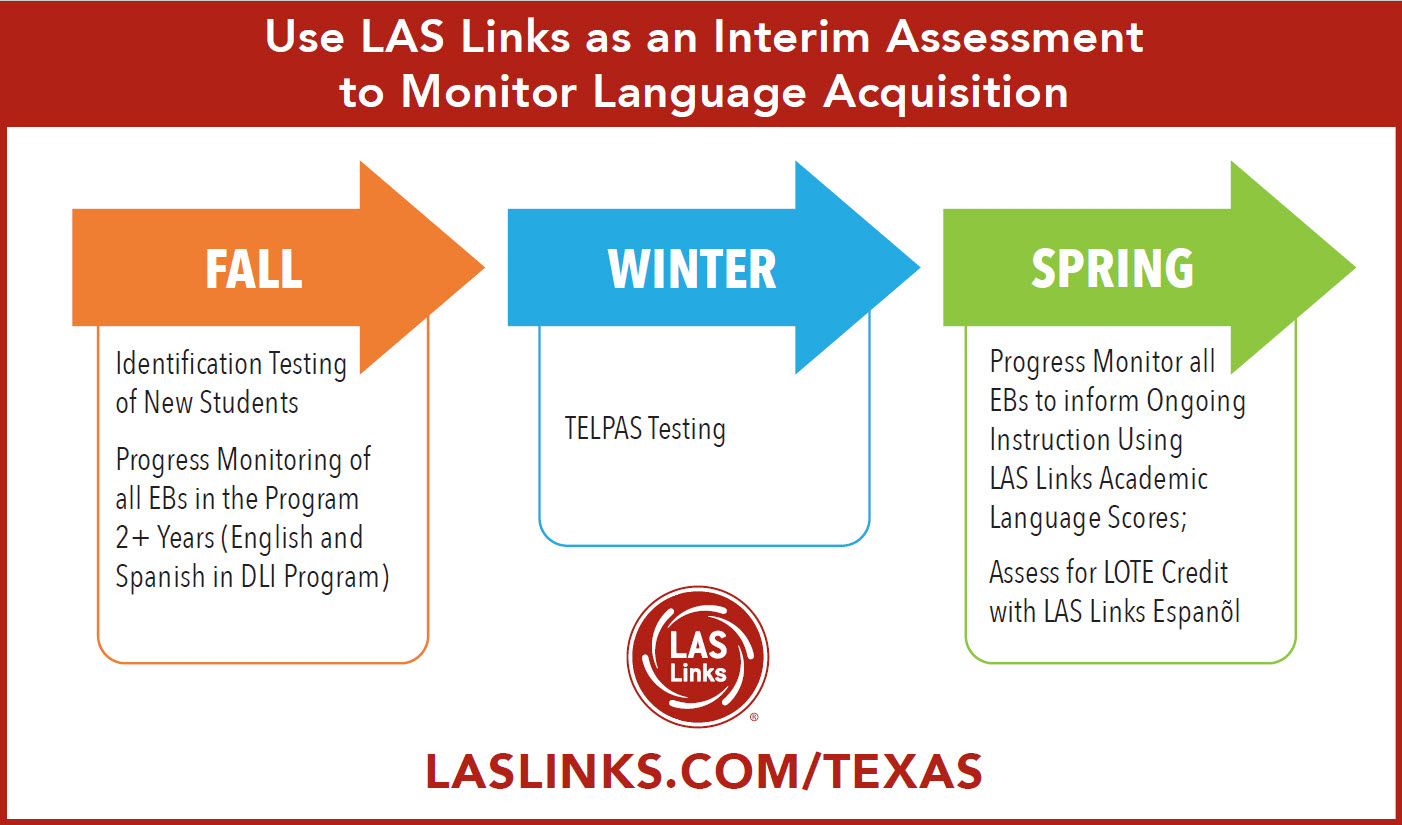LAS Links Interim Assessments
Through our work with TEA and directly with the ESCs and LEAs, DRC recognizes that LAS Links is uniquely positioned to support many of TEA’s EB initiatives with our interim assessments. The links below will show how LAS Links supports the following initiatives:
Monitoring English and Spanish Language Development
Supporting Texas LEA’s Initiatives with the LAS Battery of Assessments
LAS Links Sample Interactive Reports
Predict TELPAS Performance and Align to the Texas ELPS
LAS Links and Texas ELPS/TELPAS Proficiency Level Alignment
LAS Links to the Texas ELPS Alignment
Languages other than English: LOTE Credit
In addition to LAS Links Form A and LAS Links Español Form A, used by all Texas LEAs for the purpose of Emergent Bilingual identification, LAS Links
Español Form B may be used to satisfy the assessment requirement for LOTE credit.
For more information, contact DRC and/or view this video where DRC shares the different uses for LAS Links Español in your LOTE program, from attaining the level one LOTE credit for your dual language students to placement of heritage students among non-heritage speakers in your programs.
TABE Seal of Biliteracy
DRC’s preLAS and LAS Links assessments, available in both English and Spanish, may be used to meet the criteria of TABE’s Seal of Biliteracy criteria for an “optional standardized language proficiency assessment” at preK, 5th, 8th grade and 12th grade.
Guidance Document: Using the preLAS and/or LAS Links to obtain TABE’s Seal of Biliteracy
Diversified Support for Long Term EBs and Newcomers
LAS Links, used beyond identification, supports LEAs efforts to provide Newcomers with the targeted support that is essential to their success, not only by providing key data points to help determine instruction and classroom strategies, but to also provide critical growth data to determine Newcomer placement within and beyond your Newcomer program. Click on the link below to see how LAS Links may be used to monitor the growth of Newcomers as well as help to determine instructional needs and program placement.
Supporting Texas Newcomers with LAS Links
Chapter 89.1265 Program Evaluation Requirements with LAS Links
Annual school district reports of educational performance shall reflect: the extent to which emergent bilingual students are developing English proficiency by bilingual education and/or ESL program model, including proficiency in the partner language for students participating in a dual language immersion program model.
Click on the link below to see how LAS Links can support your LEA with the Chapter 89.1265 Program Evaluation Requirements
Meeting Chapter 89.1265 Requirements with LAS Links
Teacher Incentive Allotment
Per the TEA, LAS Links may now be utilized as a “third-party vendor assessment” to determine student growth for the Teacher Incentive Allotment.
non-EB Certified (and EB Certified) Teachers with Strategies
Webinar Series: Empowering Literacy: Making the most of your LAS Links Reading Results
With LAS Links Reading, multilingual (ML) and English learner (EL) students demonstrate their skill base in fluency, decoding, listening comprehension, and knowledge of text structure in both text and vocabulary.
Click on the link below to access DRC’s webinar series where we provide teachers and administrators with tips and tools to connect your LAS Links reading scores to classroom strategies, as well as supports designed to assist parents in their efforts to extend classroom learning into the home.
Texas LEAs: Lexile data is made available by the LAS Links Progress Monitoring forms in both English and Spanish.
LAS Links and Lexiles Webinar Series
LAS Links Instructional Strategies
preLAS Instructional Strategies
Relative Language Proficiency
Relative language proficiency (RLP) compares a student’s English proficiency scores relative to their Spanish proficiency scores. This is done to better understand the full linguistic profile of each student.
Click on one of the links below for RLP resources:
Using LAS Links to Determine Students' Relative Language Proficiency/Language Dominance
Video: Using LAS Links to Determine Students' Relative Language Proficiency/Language Dominance
RLP Targeted Strategies
RLP Sample Matrices


